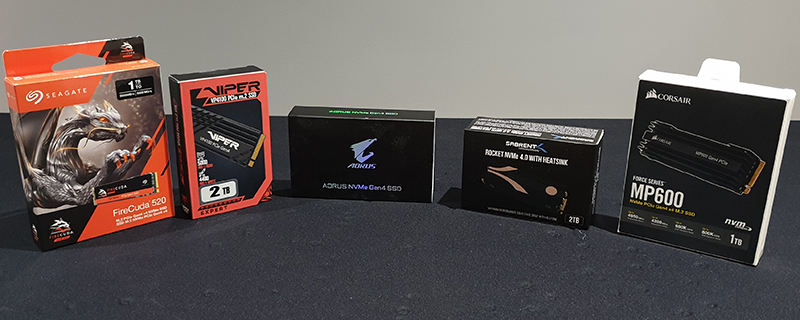PCIE 4.0 NVMe SSD Roundup
Video & Wrap Up
Two things have been abundantly clear during our testing with this set of NVMe M.2 PCI Express 4.0 drives.
Firstly, and it’s the kind of result that shouldn’t surprise anyone, the larger your heatsink the cooler the drive runs. There has been so much discussion as to whether you need a form of cooling on an M.2 drive, and with the advent of the blistering transfer rates available on the PCI Express 4.0 format that is something which has been uppermost in the mind of prospective purchasers. The drives in our temperature testing were exactly in “enormity of cooling solution” order. So if you’re determined to have the coolest drive possible, the answer is pretty clear. No, that is not buy the one with the biggest cooler, rip the cooler off and use the one designed into your motherboards heatsink. In almost every case the motherboard heatspreader was more effective than the supplied cooler, with only the enormous Sabrent one managing to squeeze a couple of extra degrees out. Given how big it is, it actually ends up being less impressive. All those heatpipes are for nought.
Secondly, we have the question as to whether the whole concept of Solid State Drives has matured to the point that you can just buy whichever you can afford or desire, or if the shift to the PCI Express 4.0 speeds has meant a return to the top of the pile for the larger brands. None of the drives we tested today have capacities so small that the old issue of buying a particularly small drive ended up crippling your speeds raised its ugly head. Neither, and whisper this, did the temperature of the drive make much of a difference either to the performance over long transfer times.
In fact, the one takeaway from all of this testing is that you can just buy whatever you like, because the performance of the drives was so uniform in so many tests, with no drive standing out for good or ill. This might not be the best news for the manufacturers, or indeed those people whose business depends upon getting you to buy third party cooling options which you clearly don’t need, but for the consumer, it’s an absolute boon. You’re not beholden to a particular brand, capacity, price tag or anything. If you want to stick with a system built using all the components from a single source you can do so without issue. Equally, if you have a tight budget but still want high performance, you can pick and choose without issue.
Of course, we’re not pretending this will be true of every single drive on the market, there are just too many, but for this particular five which have a good spread across the market in price and brand value terms, it holds up. There will be other elements to take into account such as longevity – something outside the scope of this review – or the excellence of one company’s customer service should you need to raise a ticket for any issue. Naturally, in this situation, some are better than others. But for pure “is it fast” considerations, any of the five here will leave you beaming with delight at the insane speeds you have at your disposal.
Practically all PCIe 4.0 SSDs on the market currently use Phison’s PS5016-E16, but that isn’t the only factor that’s worth considering when purchasing an SSD. SSDs often use custom firmware, different NAND suppliers and varying PCB designs. Saying that an SSD’s controller is the only factor that’s worth considering discounts the importance of these other factors, that said, all the SSDs we tested today were so close in terms of performance that their controller is clearly a limiting factor.Â
Corsair MP600 1TB is £190 from Scan
Gigabyte Aorus Gen4 2TB is £372 from Scan
Sabrent Rocket 2TB With Heatsink is £370 from Amazon
Seagate FireCuda 520 1TB is £210 from Scan
Patriot Viper VP4100 2TB is £404 from Ebuyer
We hope you had a good festive period and enjoyed this look at the various PCI Express 4.0 NVMe drive options. Discuss our findings in our always friendly OC3D Forums.



